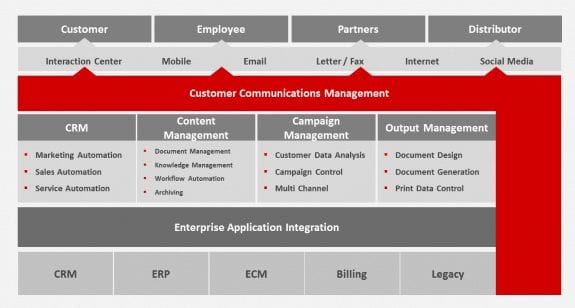The concept of Customer Communications Management (CCM) is quite broad. To understand its importance, let’s review the basics and focus on several important reasons why organizations invest in developing and executing a CCM strategy.
What You Should Know About CCM
Customer Communications Management:
- Enables corporate-wide deployment spanning different departments and functions.
- Reassigns responsibility for documents to content specialists.
- Ensures corporate image consistency.
- Minimizes compliance and liability-related risks associated with documents.
- Offers the potential to optimize costs and up-sell / cross-sell.
- Enables full control over customer communications.
- Helps avoid errors in correspondence.
- Provides a central platform for all corporate communications.
Optimization in Customer Communications
One can maximize profits while cutting costs in the area of customer communications. However, many companies still do not realize this and continue wasting money on postage and impersonal communications with customers. This situation continues to prevail, despite the fact that personalized customer correspondence can and should be optimized more often to help reach corporate goals.
A Step Ahead of the Competition with Your Customer Correspondence
The way you choose to communicate with customers can be the decisive factor that enables you to stand out in a packed competitive landscape. It is no wonder that a survey of SMEs by IBM® confirmed that customer care is taking on increasing significance for enterprises. The survey revealed that 79% of respondents ranked better customer care as the key issue facing their business.
The McKinsey Quarterly listed three facts that highlighted the rising importance of customer communications to enterprises in general:
1. 98% of enterprises lack an effective or efficient strategy on how to deal with documents.
2. For each dollar an enterprise spends on composing a document, another nine are needed to manage it.
3. Even modest investments to optimize document-related processes can have a major impact on the financial outcome.
Optimizing customer communications and all other document-related areas adds value to your IT, editing, document creation, and customer management units while distinguishing you from your competitors. Another way to distinguish yourself is by adding a personal touch to your correspondences. This increases customer loyalty as well as works in your advantage when working to win new customers. It also emphasizes to customers the importance of communication to your company.
Constant Emphasis on Costs, Control, and Quality
The 21st century’s personalized service mentality and the advancement of social media as the communications platform preferred by many consumers have brought about significant changes in the area of customer communication. Yet, the status quo of many companies remains unchanged, for example:
1. Each department communicates separately with customers.
2. Many data processing applications and IT systems are inadequately integrated, or are not integrated at all, when it comes to processing customer communications and document creation.
3. The Corporate Identity /Corporate Design are inconsistent, depending on who worked on a particular document.
4. There is no central platform for saving, managing, and extracting information.
The aforementioned issues cause problems in corporate communications. By passively reacting or not responding to the new ways in which consumers communicate, enterprises are steadily incurring rising costs. Companies experience serious financial drawbacks by choosing to deploy mostly printed correspondence (an outdated approach) instead of opting for more digital communications. Moreover, the costs associated with following-up on written correspondence are relatively high.
Wherever communications generate competitive advantage, inadequate control over those communications could mean a significant disadvantage. For instance, it can be difficult to enforce guidelines and standards of quality without keeping the proper tabs on the communication channels and documenting actions and interactions of customers and employees. Therefore, companies must constantly emphasize the costs, controls, and quality of their communications. These are the key parameters to focus on when introducing modern CCM systems to ensure standardized communications.
CCM – A Solution for Enterprises
The expression “Customer Communications Management” was used by analysts such as Forrester Research, the Gartner Group, and Madison Advisors, to define a convergent set of information technology solutions for communicating with customers (Figure 1, CCM Framework).

Figure 1. Customer Communications Management Framework.
The goal of CCM is to optimize the way enterprises communicate with their customers. This does not mean sending more offers or information to customers, but rather boosting the relevance, uniformity, and clarity of communication.
Create Personalized Correspondence for the Customer
CCM is a field in which software is used to format and personalize customer-specific content and send it in an electronic or physical form. CCM encompasses various kinds of content, including letters, bills, financial correspondence, marketing materials, reminders, offers and more.
Recognize the Hidden Potential
CCM should be one of the core competencies of any enterprise, since it facilitates direct contact with the customer, regardless of the industry or sector involved. Applications can be divided into structured, interactive, and on-demand documents.
The relevant processes fall into the 3 categories below:
Structured Documents
Structured documents are scheduled, consistently formatted, and rarely need any formal changes; thus template management plays an important role here. Such documents are often created in batches or are offset for print runs. Success thus depends on generating large volumes and controlling the print data streams.
Examples: phone bills, brokerage statements
Interactive Documents
Interactive documents require linking the customer-specific data with predefined structures. Compared with structured output, these call for a high degree of personalization. This means that the software uses a particular set of text blocks, rules, and variables to provide more individualized output based on matching customer-specific and customer-relevant data. Many enterprises would like to see templates, document structures, and text blocks controlled by specialists, while having the option to control documents through multiple channels.
Examples: customer correspondence, marketing materials, offers, contracts
On-Demand Documents
These documents are generally triggered by requests from various incoming channels of an enterprise, such as the web, fax, phone, email, and ERP systems with integrated solutions. On-demand output may be initiated automatically or manually.
Examples: service correspondence in a call center, documents from a Web portal
The CCM concept is a technical one that can be simplified regardless of the kind of output an enterprise wishes to generate. It applies mostly to the data-handling system (CRM / ERP) used to create the documents.
In addition, the concept focuses solely on a conversation with customers. Since implementation is straightforward, the IT department can return to concentrating on its main tasks once it hands over responsibility for the CCM system to content specialists.
In our upcoming posts, we will examine core components of a successful CCM strategy in detail – stay tuned!



